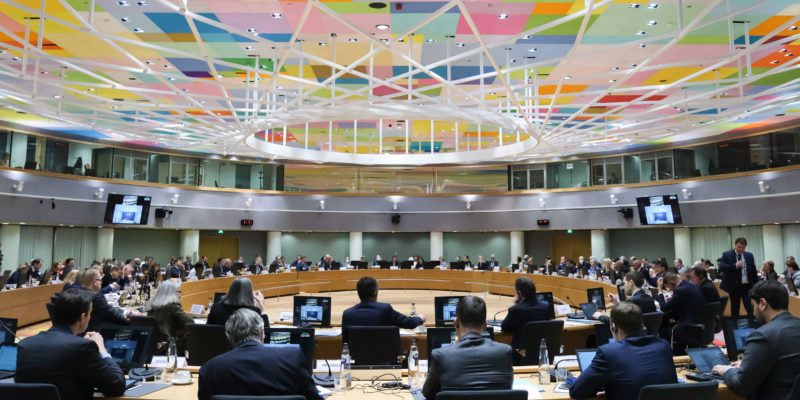Within the EU’s 10-point plan for welcoming refugees from Ukraine, the most important is probably the last point: that regarding funds. In the plan proposed by the EU Commission and unanimously approved by the Ministers of the Interior of the 27 EU countries, it is stated that “the efforts of the Member States to address the immediate and long-term scope of this challenge will have to be financially supported at the EU level”. Specifically, an EU official explained, member states, especially those bordering Ukraine, will receive “about 17 billion euro”.
This is not the definitive amount of money, but an initial allocation, supported by the “funding that is still available from the 2014-2020 program under the Cohesion Policy and Home Affairs“. It is also supported by funding under REACT-EU – in particular, its 2022 allocation of 10 billion euro”. “If there is a need, we will do more,” said Gerard Darmanin, Minister of the Interior of France, who is also the current president of the Council of the EU.
3.8 million refugees
The funds will support the reception of over 3.8 million refugees who arrived in the European Union between February 24th and March 28th. “Half of them are minors,” explained the Commissioner for Home Affairs, Ylva Johansson. “The number of arrivals is falling, from the peak of 200,000 per day to around 40,000 today, but we must continue to prepare plans. We don’t know what will happen. We need to be ready for several million more people who may come, ” she added.
The document approved by the Ministers of the Interior also provides for:
- A common IT platform for refugee registration, implemented by the EU LISA agency;
- Hubs for information and transport, supported by the European Asylum Agency;
- A mapping of the reception capacity of member states;
- An index to establish which countries will be under the greatest strain in welcoming refugees, and not only from Ukraine;
- Standard procedures for minors;
- Measures against trafficking in human beings, in particular women and children, to be implemented together with EUROPOL, thanks to the EMPACT platform.
Countries that border Ukraine are under pressure
Both the Commissioner and Darmanin have repeatedly stressed the willingness of many Ukrainian refugees to stay as close as possible to their country, in the hope of being able to return once the conflict is over. What seems to confirm this fact is that temporary protection, guaranteed by the implementation of the EU directive 55/2001, was requested by 830.000 people of the nearly 4 million who arrived.
It is an understandable choice, which, however, despite Ukrainian citizens being able to move freely within the EU, demonstrably puts border countries under pressure. Poland, for example, is home to around 1.5 million people. Moldova, which is not part of the EU, has welcomed a number of refugees that are unsustainable for one of the poorest countries in Europe. One of the ten points approved, in fact, addresses support for Moldova, which also includes the very limited relocation of 14,500 refugees to EU states.
“Unity and solidarity”
The ten points on reception came after the EU Commission presented a series of proposals for the inclusion of refugees in health, education, work and housing the previous week and after the EU heads of state and government met in Brussels for the summit on March 24th and 25th. “The European Council – as it is reported in the conclusions of the summit – recognises all efforts already made to welcome refugees fleeing the war in Ukraine, invites all member states to intensify their efforts in a constant spirit of unity and solidarity and invites the Commission to take all necessary initiatives to facilitate these efforts”.
“Unity and solidarity” are words that Johansson also used, speaking of “a positive, constructive and pragmatic approach” on the part of the Ministers of the Interior and underlying the difference with respect to past divisions in the field of immigration. The differences with respect to the management of the phenomenon in past years are evident. However, some critical aspects still remain and could grow, depending on the evolution of the conflict and the situation.
What about quotas and relocations?
It is not clear, for example, how the EU Ministers of the Interior have evaluated the proposal by Poland and Germany, to allocate one thousand euros to the host state for each refugee for six months. Certainly, there is no mention of this in the final document. The idea is linked to that of quotas, to redistribute refugees in a proportionate manner among all member states. For now, it seems like this option has not been taken into consideration, or at least this is what several EU officials have declared.
Paradoxically, Poland, which would benefit from it, seems to oppose the measure because it would set a dangerous precedent. Warsaw, in fact, in the past years has always rejected this type of proposal for refugees arriving in Mediterranean countries such as Italy and therefore would now prefer to receive substantial funding for reception or to see at least some of the people who arrived from Ukraine to leave spontaneously. Hungary and Czech Republic seem to share the same views on this issue.
In this regard, Johansson explained that about one million refugees have already moved to non-border countries and said that “it is important to encourage Ukrainians to leave Poland to go to other member states”. The question is if and how this will happen. According to Lucas Rasche of the Jacques Delors Center, “EU states should integrate the free movement of Ukrainians with a voluntary transfer scheme”. “This – wrote the analyst – is not only necessary to prevent further overload in the countries of first arrival, but is also essential to ensure that refugees can fully claim the rights granted to them by the Temporary Protection Directive”.
Cover photo: Extraordinary Justice and Home Affairs Council Roundtable with the Ukrainian Minister of Interior via vtc









